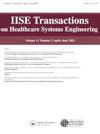A novel self-adaptive convolutional neural network model using spatial pyramid pooling for 3D lung nodule computer-aided diagnosis
IF 1.5
Q3 HEALTH CARE SCIENCES & SERVICES
IISE Transactions on Healthcare Systems Engineering
Pub Date : 2021-09-23
DOI:10.1080/24725579.2021.1953638
引用次数: 5
Abstract
Abstract This research proposes a novel self-adaptive convolutional neural network (Adap-Net) model for lung nodule diagnosis on 3D computed tomography (CT) images. Lung cancer is one of the most common cancers with a high mortality rate. Therefore, there is an urgent need to diagnose lung nodules to improve the survival rate, which is challenging because of the nodule heterogeneity and the lack of annotated lung nodule images. Prevailing research for lung nodule diagnosis usually ignores the nodule heterogeneity problem and enlarges the model complexity that degrades the lung nodule diagnosis performance given limited annotated training samples. To overcome the challenges, a transverse layer pooling (TLP) algorithm is proposed and the spatial pyramid pooling (SPP) scheme is integrated, which makes it possible to adaptively extract equal-dimensional feature representations from arbitrary-sized 3D lung nodule images. Meanwhile, the TLP algorithm introduces a layer compression architecture that dramatically reduces the model complexity. Moreover, K-means clustering is adopted to assign appropriate input image sizes for each lung nodule, allowing the mini-batch-based model training. The proposed Adap-Net is comprehensively evaluated and compared to other deep learning (DL) models using 3D CT images from a public dataset. Experimental results show that the proposed Adap-Net model improves the lung nodule diagnosis accuracy up to 12.12% with less than 10% of parameters that are involved in other DL models. In practice, the proposed Adap-Net model can offer complementary opinions in computer-aided diagnosis (CAD) systems as a supportive tool for radiologists and physicians in the medical image interpretation, analysis, and diagnosis process.一种新的基于空间金字塔池的自适应卷积神经网络模型用于三维肺结节计算机辅助诊断
摘要本研究提出了一种新的自适应卷积神经网络(Adap-Net)模型,用于在三维计算机断层扫描(CT)图像上诊断肺结节。癌症是最常见的癌症之一,死亡率很高。因此,迫切需要诊断肺结节以提高生存率,这是具有挑战性的,因为结节的异质性和缺乏注释的肺结节图像。现有的肺结节诊断研究通常忽略了结节异质性问题,并在有限的注释训练样本的情况下扩大了模型的复杂性,从而降低了肺结节诊断性能。为了克服这些挑战,提出了一种横向层池化(TLP)算法,并集成了空间金字塔池化(SPP)方案,这使得从任意大小的3D肺结节图像中自适应地提取等维特征表示成为可能。同时,TLP算法引入了一种层压缩架构,大大降低了模型的复杂度。此外,采用K-means聚类为每个肺结节分配适当的输入图像大小,允许基于小批量的模型训练。使用来自公共数据集的3D CT图像对所提出的Adap-Net进行了全面评估,并将其与其他深度学习(DL)模型进行了比较。实验结果表明,所提出的Adap-Net模型将肺结节的诊断准确率提高到12.12%,而其他DL模型所涉及的参数不到10%。在实践中,所提出的Adap-Net模型可以在计算机辅助诊断(CAD)系统中提供补充意见,作为放射科医生和医生在医学图像解释、分析和诊断过程中的支持工具。
本文章由计算机程序翻译,如有差异,请以英文原文为准。
求助全文
约1分钟内获得全文
求助全文
来源期刊

IISE Transactions on Healthcare Systems Engineering
Social Sciences-Safety Research
CiteScore
3.10
自引率
0.00%
发文量
19
期刊介绍:
IISE Transactions on Healthcare Systems Engineering aims to foster the healthcare systems community by publishing high quality papers that have a strong methodological focus and direct applicability to healthcare systems. Published quarterly, the journal supports research that explores: · Healthcare Operations Management · Medical Decision Making · Socio-Technical Systems Analysis related to healthcare · Quality Engineering · Healthcare Informatics · Healthcare Policy We are looking forward to accepting submissions that document the development and use of industrial and systems engineering tools and techniques including: · Healthcare operations research · Healthcare statistics · Healthcare information systems · Healthcare work measurement · Human factors/ergonomics applied to healthcare systems Research that explores the integration of these tools and techniques with those from other engineering and medical disciplines are also featured. We encourage the submission of clinical notes, or practice notes, to show the impact of contributions that will be published. We also encourage authors to collect an impact statement from their clinical partners to show the impact of research in the clinical practices.
 求助内容:
求助内容: 应助结果提醒方式:
应助结果提醒方式:


